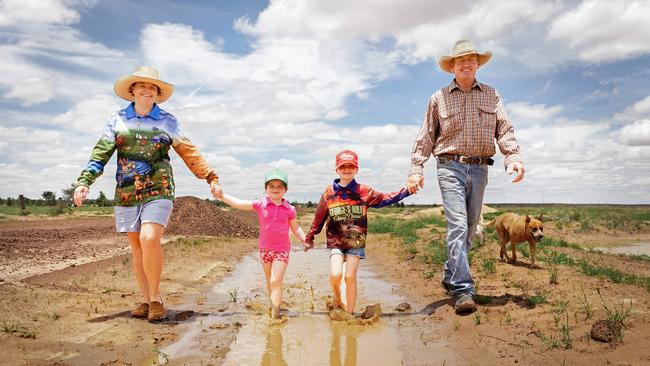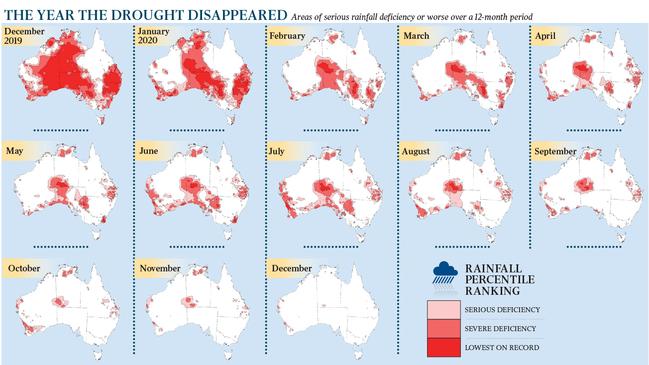We’ve seen fire, and now we’ve seen rain as farmers celebrate the big wet
The skies opened over Australia in 2020 and a landscape scorched by drought and fire soaked it up, restocking dams, replenishing withered rivers and giving fresh hope to farmers.

The skies opened over Australia in 2020, and a parched landscape cracked by drought and scorched by fire gleefully soaked it up.
Now the great rain-soaked recharge has started to restock dams, replenish withered rivers and give fresh hope to farmers.
With La Nina weather conditions bringing an early start to the monsoon rains in the north — and the promise of a wetter-than-usual summer elsewhere — the restoration is set to continue.
The changed fortunes have been brought to life in maps published by the Bureau of Meteorology, which says the outlook is for wetter conditions this summer, but also warns that much more rain is still needed to make up for years of deficit.
Last January, the map of the country was ablaze with red, marking the areas of historic rainfall deficiency. But as each month ticked by during 2020, the areas of red contracted, and they have now all but disappeared.
The bureau’s latest drought map for January 1 to December 31, 2020, shows only small patches of rainfall deficit in Queensland, in the dead red centre, and in Western Australia.
The result has been a bumper year for agriculture. According to the Australian Bureau of Agriculture and Resource Economics, the 2020–21 gross value of agricultural production is expected to top $65bn, thanks to the nation’s second-largest winter crop.
Indeed, the rainfall has been so good that the National Farmers Federation has declared the drought over.
“We are a wide brown land, and invariably there are some areas that are dryer than others,” an NFF spokesperson said. “But by and large we are not in drought as a nation overall.”
The onset of welcome rains after a long drought continues a cycle captured by the Bureau of Meteorology in a graphic of annual rainfall since 1900.
The annual snapshot shows a rhythm of wet and dry, with notable rains occurring in 1917, 1950, 1955, 1974, 2000 and 2011.
Dry years include 1902, 1905, 1928, 1944, 1961, 1994, 2002, and a dramatic fiery image of 2019.

Officially, the issue of whether or not a drought has truly broken is not clear cut. Drought declarations are made by state agencies, and there are still several areas of concern.
At the end of 2020, 90 per cent of NSW, for example, was considered to be “non-drought” or “in recovery”. Rainfall accumulation for 2020 was near or above average across NSW.
In Victoria, good seasonal conditions were experienced during spring and into early summer last year, but there are localised areas south of Sale and around Upper Tambo Valley that Agriculture Victoria is monitoring due to continued dry conditions.
Dry conditions continue in much of Queensland, where in December there were a total of 41 councils and four part-council areas were drought-declared. These declarations represent 67.4 per cent of the land area of the Sunshine State.
On their property 20km outside Barcaldine in western Queensland, Teneille and Rodney Ham were celebrating 78mm of rain in their gauge after heavy falls this week
“It was a welcome relief,” Ms Ham said. “We’ve had bits and pieces of rain, but we’ve had our fingers crossed for something like this.” She said their two young children — Sophie, 7, and Jayden, 5 — had taken the opportunity to enjoy the water. Like many children of the outback, they “don’t always have that luxury of having water around”, she added.
The recent downfall was the most rain the couple had seen on the property since they moved there 18 months ago from nearby Alpha.
Ms Ham said the downpour had improved the family’s outlook for 2021. “We’re always optimistic on the land,” she said. “Hopefully (the rain) can answer a few more prayers for people.”
In South Australia, about 70 per cent of the state is still listed as being drought-affected.
Western Australia’s Department of Primary Industries and Regional Development is forecasting better-than-average rains for January, but says farm water supplies remain low and soil-water storage is very low in the central and eastern grain belt.
In the Northern Territory, the monsoon rains have come early, which is typical of the La Nina weather pattern that is expected to bring continued wet conditions to eastern Australia this year.
The message from the BoM is that continued good rains are needed. The bureau says Australia has experienced a prolonged period of below-average rainfall spanning several years.
Rainfall deficiencies have affected much of Australia since early 2017. More than half of the continent was in severe rainfall deficiency from April 2018 to November 2020.
The BoM says the size of the rainfall deficit accumulated over annual and longer timescales remains very large over much of Australia. It says persistent, widespread and above-average rainfall is needed to lift areas out of deficiency and provide relief from the harsh effects of this long period of low rainfall.
The wet conditions of 2020 have also restocked metropolitan water storages around the country. Sydney’s water storage is now 97.3 per cent full — more than double the 45 per cent last year.
Melbourne’s water storage stands at 75.2 per cent, up from 63 per cent, and Brisbane reservoirs are 59.7 per cent full, up from 58.2 per cent last year.
Adelaide storage has risen to 62.5 per cent from 50 per cent, and Hobart is at 96.8 per cent, up from 62.2 per cent.
The BoM says the impact of the long dry on water resources is still evident, especially in northern parts of the Murray-Darling Basin, where storage is still low.
Additional reporting: Rhiannon Down




To join the conversation, please log in. Don't have an account? Register
Join the conversation, you are commenting as Logout